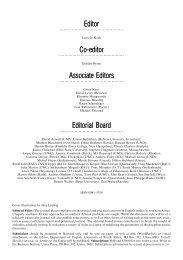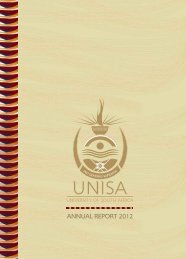pdf: 6.426kb - University of South Africa
pdf: 6.426kb - University of South Africa
pdf: 6.426kb - University of South Africa
You also want an ePaper? Increase the reach of your titles
YUMPU automatically turns print PDFs into web optimized ePapers that Google loves.
The idea that certain plants are teachers is even<br />
found in highly syncretic, modern rural-urban cults. In<br />
Brazil, in the state <strong>of</strong> Acre, there are groups that use<br />
the beverage prepared from Banisteriopsis caapi and<br />
Psychotria viridis under the name Santo Daime,<br />
because it is believed that these plants heal both the<br />
body and the soul and teach the doctrine <strong>of</strong> Jesus<br />
Christ (McKenna 1995:354).<br />
Among vegetalistas there are several specializations,<br />
according to the main plant used. Luna (1986:32±33)<br />
classifies them as follows:<br />
Ð Ayahuasquero: the person who uses ayahuasca<br />
in his visions and healing. Normally a potion made<br />
from the vine <strong>of</strong> Banisteriopsis caapi, and the<br />
leaves <strong>of</strong> Psychotria viridis. The admixture may<br />
differ, but the main ingredient will always be the<br />
Banisteriopsis vine (Luna 1986:32).<br />
Ð Camalonquero: the person who uses camalonga.<br />
According to Luna (1986; 1991) this plant was<br />
still unidentified, but Duke & Vasquez (1994)<br />
identified it as Thevitia peruviana. I disagree with<br />
this identification, since the Thevitia peruviana are<br />
found all over the jungle. The seeds are also used<br />
as beads by many women in the selva (jungle). I<br />
have learned from my informant camalonqueros,<br />
that the camalonga plant does not grow in the<br />
selva itself, but comes from the sierra (mountainous<br />
area) <strong>of</strong> Peru. See also Luna (1986:32;<br />
1991:13).<br />
Ð Tabaquero: the person who uses tobacco. This<br />
tobacco is not the commercial grades <strong>of</strong> Nicotiana<br />
tabacum, available today, but Nicotiana<br />
The author, Wynand Koch, holding a painting received from<br />
Shaman Don Francisco<br />
rustica, a species much more potent, chemically<br />
complex, and potentially hallucinogenic (McKenna<br />
1992:196).<br />
Ð ToeÂro: the person who uses toeÂ. Luna (1986;<br />
1991) identified this plant as Brugmansia sauveolens,<br />
Duke & Vasquez (1994:64) as the Datura<br />
arborea and Dobkin de Rios (1984:130) as the<br />
Datura sauvoleons. Talking to my toeÂro informants,<br />
I found the toe to be <strong>of</strong> the Datura sp.<br />
Ð Palero: the practitioner who has learned from<br />
palos (sticks). Paleros use the bark <strong>of</strong> various large<br />
trees such as ayahuÂman (Couroupita guianensis),<br />
huacapu (Minguartia guianensis), clavohuasca<br />
(Tynanthas panurensis), chuchuhuasa (Heisteria<br />
pallida), chullachaki-caspi (Brysonima christianeae),<br />
remocaspi (Aspidosperma excelsum) and<br />
many others (Luna 1991:13).<br />
Ð Catahuero: he person who uses catahua Ð Hura<br />
crepitans (Luna 1986:33).<br />
Besides vegetalistas, Luna (1986:33) also classifies<br />
other types <strong>of</strong> practitioners:<br />
Ð Oracionistas: who use mainly prayers and<br />
encantations in their practice.<br />
Ð Perfumeros: who practise a sophisticated sort <strong>of</strong><br />
`aromatherapy'.<br />
Ð Espiritualistas: who deal with spirits.<br />
This is just a basic classification, since I have found<br />
that the same vegetalista <strong>of</strong>ten may master several <strong>of</strong><br />
these plants, and use them regularly. All my informants<br />
used more than one plant. Don Fernando, a<br />
camalonquero, made use <strong>of</strong> the camalonga and<br />
ayahuasca, in the same ceremony, drinking it consecutively.<br />
It is also a problem to distinguish oracionistas,<br />
perfumeros and espiritualistas from<br />
vegetalistas, since most <strong>of</strong> them use one or another<br />
plant. Don Francisco, a perfumero, also made use <strong>of</strong><br />
the ayahuasca in his ceremonies, so did DonÄ a Otilia,<br />
an oracionista.<br />
I have found the terms maestro, banco and brujo<br />
<strong>of</strong>ten used. A vegetalista in training will always refer<br />
to his teacher as maestro, even after he has completed<br />
his training. I have found the term banco to refer to<br />
vegetalistas <strong>of</strong> great knowledge. According to one <strong>of</strong><br />
my informants, Don Francisco, a banco is a practitioner<br />
who lies face down on the floor, then enters<br />
into trance with the spirits descending upon him, as<br />
though he was a bench (banco). Further, Don<br />
Francisco also sees the banco as a vegetalista, able<br />
to travel between the three realms <strong>of</strong> mestizo<br />
cosmology. Bancos are hard to find, since they are<br />
considered to be men <strong>of</strong> exceptional knowledge. The<br />
term brujo negro is used for a vegetalista who<br />
practises black magic, in other words, who uses<br />
medicinal herbs and casts spells to cause harm to<br />
50 ISSN 0256±6060±Unisa Lat. Am. Rep. 16(2) 2000

















